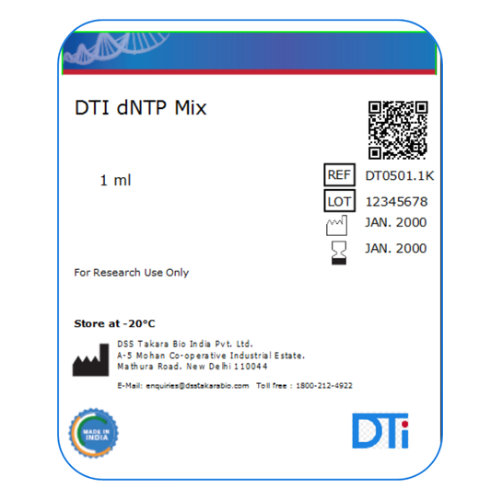DTI dNTP Mix
DTI dNTP Mix
Our dNTPs for PCR are ≥98% pure and are tested for quality control in a variety of applications. Individual dNTPs are supplied at a concentration of 10 mM and can be diluted with water or buffer as needed. The mixture contains each dNTP at a concentration of 10 mM.
SKU:DT0501.1K

DTI dNTP Mix
| Brand | Catalogue Number | Pack Size |
|---|---|---|
| DTI dNTP Mix | DT0501.1K | 1 ml |
Product Description: DTI dNTP Mix (10 mM each) is a mixture of dATP, dCTP, dGTP, and dTTP.
Components: DTI dNTP Mix (10 mM each) - 1 ml
Concentration: 10 mM each
Form: Solution (sodium salt), (pH 7.0 - 9.0)
Storage: -20°C. Avoid repeated freeze-thaw cycles. Once thawed, aliquot into separate tubes and store at –20°C.
Purity: >98%
Performance:
- Good performance was confirmed by PCR amplification of 500 bp and 20 kb fragments from λ DNA template.
- Good performance was confirmed by RT-PCR amplification of a 4.4 kb fragment of the human TFR gene from HL60 cell total RNA.
Applications:
- Ready-to-use: Can be used in PCR reactions without dilution or after diluting to 2.5 mM dNTP.
- RT-PCR
- DNA cloning, sequencing, and labeling.
- Use as a substrate for other DNA amplification and cDNA synthesis reactions.
DTI dNTP Mix - Protocol and Downloads
| Document | Download Link |
|---|---|
| DTI dNTP Mix - Protocol | Download User Manual |
| DTI dNTP Mix - Certificate of Analysis | Download CoA - DT0501.1K |
Experimental Sample Results using dNTP Mix
Consistent amplification of 500 bp fragment from λ DNA is observed using 10 mM dNTP in the RR002M TaKaRa LA Taq® DNA Polymerase (Mg2+ plus buffer) PCR system.
The protocol used for the assay and the results are as follows:

Figure 1: Amplification of 500 bp fragment from λ DNA using dNTP in the PCR system.
Consistent amplification in RT-PCR was confirmed using total RNA from HL60 cells as a template (amplified fragment: TFR region 4.4 kbp). dNTP has been used in the Takara cat# PrimeScript™ RT-PCR Kit RT PCR system.
The protocol used for the assay and the results are as follows:

Figure 2: RT-PCR amplification using dNTP in the PrimeScript™ RT-PCR Kit.
FAQ - DTI PCR Enzymes
It is important to note that a salt concentration above 50 mM can inhibit Taq polymerases.
When designing primers, pay special attention the following parameters:
- Homology with the target nucleic acid sequence
- Length
- GC content
- Concentration
- Primer homology (primers should not have homology either internally or with one another, especially at the 3' ends)
Nested PCR frequently leads to improved yield of the desired PCR product by:
- Eliminating extra bands that may have been present in the initial PCR
- Producing a robust band that may have been weak or invisible in the initial PCR
- Homoduplexes—annealing of complementary strands
- Heteroduplexes—cross-hybridization of homologous sequences that may have partial homology
- Duplexes between primers and template
- 5 cycles at 72°C, then
- 5 cycles at 70°C, then
- >25 cycles at 68°C
Don, R. H., et al. 'Touchdown' PCR to circumvent spurious priming during gene amplification. Nucl Acids Res. 19(14):4008 (1991).
High-fidelity polymerases are recommended for gene cloning, protein expression, structure-function studies of proteins, cDNA library construction, and next-generation sequencing.
When pipetting enzyme from a stock tube, place the end of the tip just far enough into the liquid to obtain the desired volume. A pipette tip should not be plunged all the way into the enzyme solution as the outside of the tip will become covered with enzyme, preventing accurate measurement and wasting enzyme.
Note: The retention of liquids to polypropylene tips varies with different types of solutions. Pipette tips lose their precision when liquid is drawn more than once. Low-retention pipette tips are recommended for use with viscous solutions, such as those containing glycerol.

